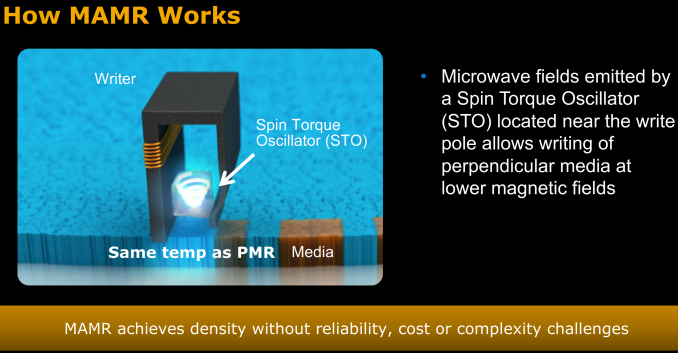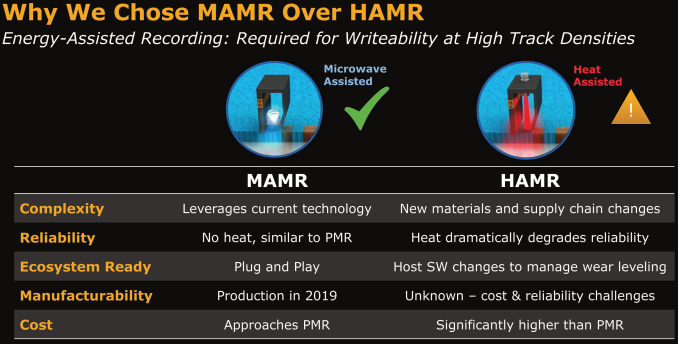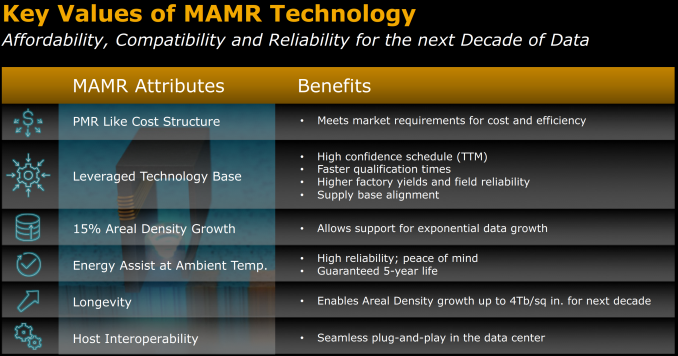Western Digital Stuns Storage Industry with MAMR Breakthrough for Next-Gen HDDs
by Ganesh T S on October 12, 2017 8:00 AM ESTMicrowave Assisted Magnetic Recording (MAMR)
The WD Breakthrough
Western Digital's Microwave Assisted Magnetic Recording (MAMR) drives use platters very similar to those in the current-generation PMR drives*. This means that the innovation to enable MAMR is mainly to do with the heads that perform read and write operations.
As part of the MAMR design, WD pointed out to its shift to the damascene process for building the bit grains as the key enabler for the MAMR breakthrough. The process allows them to fabricate a spin torque oscillator (STO) capable of creating precise energy fields without any additional overheads. The embedded oscillator in the head is tuned to generate microwaves with a frequency of 20-40 GHz, and this provides the 'energy-assist' to make it easier to write to the bits (technically it lowers the coercivity of the underlying recording media).
* Current drives use an aluminium substrate with a cobalt-platinum layer.
WD pointed out that MAMR requires absolutely no external heating of the media that could lead to reliability issues. The temperature profiles of MAMR HDDs (both platters and drive temperature itself) are expected to be similar to those of the current generation HDDs. It was indicated that the MAMR drives would meet all current data center reliability requirements.
Based on the description of the operation of MAMR, it is a no-brainer that HAMR has no future in its current form. Almost all hard drive industry players have a lot more patents on HAMR compared to MAMR. It remains to be seen if the intellectual property created on the HAMR side is put to use elsewhere.
Western Digital has talked about timeframes for the introduction of MAMR drives. They had working prototypes on display at the press and analyst event yesterday. WD's datacenter customers have their own four to six month qualification cycle, and MAMR drives for that purpose are expected to be out towards the middle of next year. Production-level HDDs based on MAMR technology are expected to start shipping in 2019.
Western Digital sees plenty of value in MAMR, and it is not hard to see why. MAMR technology allows for the bit densities of individual platters to scale to more than 4 Tb/sq.in. WD believes that it is well-positioned to bring 40TB drives by 2025 using MAMR alone.
Technologies such as SMR and TDMR are complementary to MAMR. Currently, WD does not use TDMR in any shipping enterprise drive, and SMR is restricted to a few host-managed models. It is possible that some MAMR drives will use those technologies to achieve higher capacity points compared to conventional drives. WD's working prototype on display was a helium drive (HelioSeal), but, WD again stressed that helium is not a compulsory requirement for MAMR drives. It was also confirmed that drives of 16TB and more would have to be MAMR-based.
In 2005, when the shift from longitudinal recording to PMR happened, most vendors managed to release drives based on the new technology within a few years of each other. The shift to helium in 2012, though expected by everyone in the industry, proved to be a big win for HGST - they had the markets that focus on high-capacity, or low-power, or low TCO to themselves for almost three years before Seagate eventually caught up. Toshiba is yet to release a helium drive publicly. It is going to be interesting to see how Seagate and Toshiba respond to this unexpected MAMR announcement from Western Digital.
The players in the hard drive industry have a robust cross-licensing program, and it is highly likely that other manufacturers will not face significant patent bottlenecks in bringing out MAMR drives on their own. WD stressed that the development is a multi-year effort, particularly if the heads are still being manufactured in the old dry pole process.
High-volume mature hard drives are often manufactured with the help of third-party suppliers - such as Showa Denko for the recording media and TDK for the heads. In the case of the MAMR drives, WD mentioned that all the components are being designed and manufactured in-house. It is possible for the competition to catch up faster if some of the third-party manufacturers are further along in their own R&D. In particular, TDK has been investing in MAMR R&D recently too. Toshiba has also shown interest in the same, but it is not clear how far along they are in the commercial development cycle. Currently, we believe WD has a clear lead in MAMR technology. It just remains to be seen how long it takes for the competition to catch up.














127 Comments
View All Comments
Glaurung - Thursday, October 12, 2017 - link
Mac OS has calculated storage capacity using TB rather than TiB for years now.lmcd - Thursday, October 12, 2017 - link
That'll happen when general users refer to Gibibytes instead of Gigabytes, etc.melgross - Thursday, October 12, 2017 - link
For crying out loud. I wish we could get over this nonsense. You do realize that it's the same amount of storage? It doesn't matter which number is used, as long as everyone uses the same way of describing it.mapesdhs - Thursday, October 12, 2017 - link
It matters because computing by its very nature lends itself to the binary world, powers of 2, hex, etc., and the idea of not doing this for describing disk capacities only started as a way of making customers think they were getting more storage than they actually were. When I was at uni in the late 1980s, nobody in any context used MB, GB, etc. based on a power of ten, as everything was derived from the notion of bytes and KB, which are powers of 2. Like so many things these days, this sort of change is just yet more dumbing down, oh we must make it easier for people! Rubbish, how about for once we insist that people actual improve their intellects and learn something properly.Anyway, great article Ganesh, thanks for that! I am curious though how backup technologies are going to keep up with all this, eg. what is the future of LTO? Indeed, as consumer materials become ever more digital, surely at some point the consumer market will need viable backup solutions that are not ferociously expensive. It would be a shame if in decades' time, the future elderly have little to remember their youth because all the old digital storage devices have worn out. There's something to be said for a proper photo album...
BrokenCrayons - Thursday, October 12, 2017 - link
I have a few decrepit 5.25 inch full height hard drives (the sorts that included a bad sector map printed on their label made by companies long dead to this world) sitting in a box in my house that were from the 80s. They used a power of ten to represent capacity even before you attended university. This capacity discussion is absolutely not a new concern. It was the subject of lots of BBS drama carried out over 2400 baud modems.bcronce - Thursday, October 12, 2017 - link
For the longest time where was no common definition of a "byte". 5 bit byte? 6 bit byte? 7 bit byte? 11 bit byte? Most storage devices were labeled in bits, which is labeled in base 10.melgross - Thursday, October 12, 2017 - link
Sheesh, none of that has any importance whatsoever outside of the small geeky areas in this business.alpha754293 - Thursday, October 12, 2017 - link
...except for the companies that got sued for fraudulent advertising, because 'Murica!Ratman6161 - Thursday, October 12, 2017 - link
"It doesn't matter which number is used, as long as everyone uses the same way of describing it."You would be amazed at how many times I still get the question : "Did I get ripped off? Windows says my hard drive is smaller than what <insert PC OEM here> said in their specs!"
melgross - Thursday, October 12, 2017 - link
That's why changing the way we describe this every few years is a problem. We need a standard to be used everywhere, no matter which one. Quite frankly, almost no one will ever do what your friends, according to you, do. Most don't even know offhand, who makes their computer, much less how much storage it comes with.